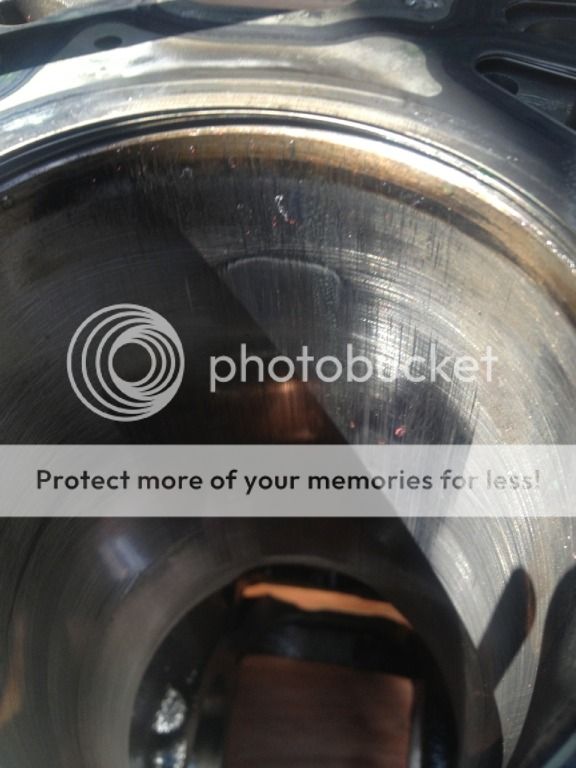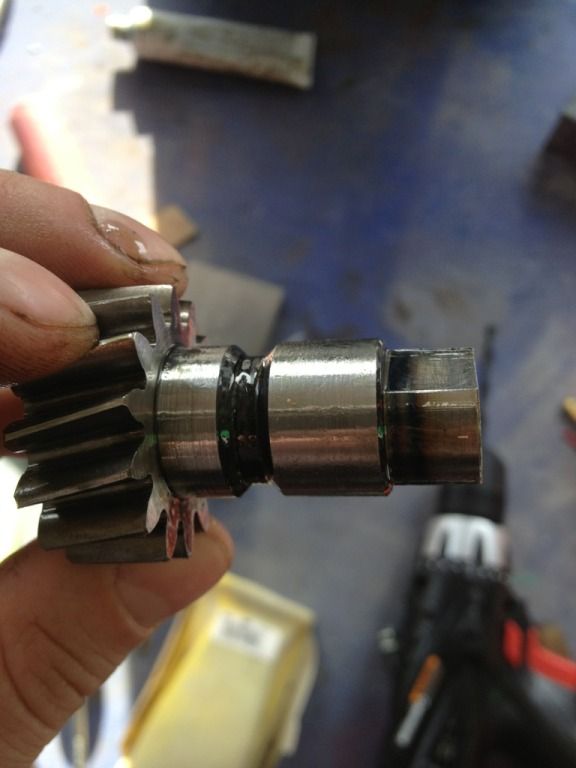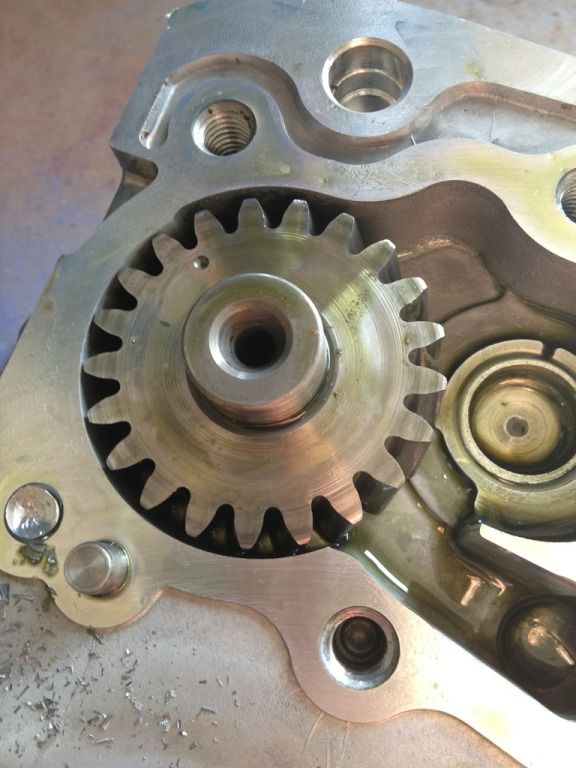Ask them to check piston to bore clearance. It may have been a little tight.
Eventually I’ll have the block and crank back in my hands to re-do all the clearances. I’ll check, however I think it was debris for one reason. Since pistons are slightly oval wouldn’t you think a clearance issue would have really concentrated the damage to the center of the pistons? However, the abrasions seem uniform across the skirts and even to the top of the piston.
It is quite possible that debris caused this issue, however you would also see deep grooves in the cylinder bores that you could catch your finger nail on.
Most modern pistons are cam ground (oval) but that is to allow for proper expansion and minimal thrust wear when cold. If you are seeing large scuffs on the thrust side of the piston it is an indication of a tight piston to bore clearance (or a lot of detonation but you would most likely see cracked ring lands). The higher the horsepower the more heat that is produced. The more heat that is concentrated in the piston the greater the expansion. When the clearance is too tight the piston cannot expand anymore and the additional friction shows up as thrust side wear.
You can measure the pistons one inch above the bottom of the skirt. They should be all the same dimension. If you see a difference or a smaller dimension across all four then chances are the pistons are worn and may indicate the need for replacement.
Some people set piston to bore clearance to the recommended number on the piston card but many add some clearance to allow for enough expansion. Most people I know who are building 4G63s professionally are setting them to .004"-.0045". This is shown to prevent a lot of thrust side wear. Especially on cylinder one where cooled coolant is coming in from the radiator at the water pump and tends to slightly tighten up the bore due to the difference in temperatures. I have seen a few 4G63 engines that were running .003"-.0035" clearance with forged pistons and a higher than stock amount of boost have somewhat similar thrust wear. As a result I started using the recommended .004"-.0045" minimum. After pulling one down for rebuild the thrust wear was perfect and this was on a stroker where you would expect to see some considerable side loading thrust wear.
Building engines, like anything in life, has a degree of subjectivity. Do what you feel is best and good luck.
If all your skirts are like that the piston to wall was to tight for the heat generated or it was knocking like crazy
Thanks for the insight.
I guess I have a hard time believing Buschur would let this motor leave with too tight of a piston to wall clearance. He assembles hundreds of these motors a year without any issues. Additionally, I found debris in the ring lands and wrist pin. I know the tuning isn’t an issue, as Emery tuned it. Also, E85 has a tendency to shoot rods out the block before knock occurs.
This isn’t my first walk in the park building 4g63’s btw. I have probably $2000 in machinist tools at my disposal including a torque plate for this motor. I know the clearances I’d use in a block (and have); but this motor has a few things going for it I have yet to experience.
- Aluminum rods
- Stroker, Asymmetrical pistons
- I’m trying to re-use parts.
I’ve never had to look at a used race part and determine if it’s “Okay” to use again. Sure, maybe these pistons are savable. Maybe that’s typical wear for a stroker piston that has a noticeably shorter skirt. Or they could be beyond damaged because of debris/whatever reason.
Once I get the “OK” from Klispies about the condition of my crank and block, then I’ll go from there. The crankshaft I dropped off may very well be cracked or bent, as I bought it used. The block may be garbage, as the mains may be too out of round to save. Additionally I have to think of things as far as cylinder condition… If the block needs to be punched out another .010 I may be SOL; I don’t feel comfortable running a .020 block at the power levels I make. Additionally, the block is o-ringed which makes things even more complex and expensive.
I have a lot of factors that will determine the outcome of this engine. I may, perhaps be SOL and have to start fresh. Or I may be slightly SOL and have a motor that isn’t particularly useful for the power levels I’m running.
Good luck. If you need a used engine I think DeviousTSI may have a spare at his house.
Might have to take him up on that. I appreciate the advice man, you seem extremely well versed in 4g63’s.
I hope I don’t come off unappreciative, because I’m anything but that. I’m just a bit frustrated with this situation; the farther I got into this motor the more I realized things didn’t meet my personal standards ![]()
No problem. Diagnosing an engine failure is like trying to figure out how you got herpes. It’s never fun.
I’m sure that everyone involved in putting this engine together did their part adequately.
I still have my torque plate, I didn’t know that anyone else in the area had one.
First pic looks a little rough.
I agree. I was in such a hurry to get everything to the machine shop I never felt inside the bores to see if it was rough or just the piston skirt coating/grease on there. Knowing my luck, it’s probably too deep to just hone it out.
I guess I’m just curious as to what caused this all. Once I get the block and stuff back from the machine shop, I’ll know for sure if it was a clearance issue or not.
That polished look would be almost certainly another .010". You are only talking about .005" per side and the block is iron. If the mains are okay I would run it
Looking at the piston size, I think this may be just an opened up stock bore, which is good (Pistons measure 3.348"). However, now I’m worried that punching the block out .010 over will cause issues with the SS orings on the deck.
-Alex
Edit: F it, I’m driving to NYC to pick up a spare block. Worse case scenario, I have a second motor I can build.
3.348" is 85mm which is stock bore. Aftermarket pistons come in .5mm oversizes and that equates to .020". Minimum you would have to bore and hone is +.020"
Turns out the oil pump was not the culprit. I finally got inside of it after drilling out the stupid Philips head bolt out.
There was just bearing material inside it which made it excessively hard to turn. The oil pump itself looked pretty mint, Including the front shaft which had no play and spun nicely.
What’s your take on this? Would you conclude that the mains spun first?
If you have a sudden loss of oil pressure the first thing to fail would be rod bearings as they are last in lined to be oiled in a priority fed oiling system. Mains first, rods second. Did your mains spin as well?
I’m still going with the timing belt tension based on the wear of the pump cover and the bore that the gear shaft passes through (based on the pictures and not seeing everything first hand). What viscosity oil were you running? Synthetic or standard?
Only the mains spun, the rods looked okay. I think the dowel pin held them in place though (aluminum rods)
I believe 10w30 and brad penn
My bet is that whoever bought this car from Cessna had no idea what they were doing and put regular oil in it and not the brad penn 20-50 that Buschur advises to run. From talking to Cory and the guys at STM, they hadn’t seen the car in awhile so it probably wasn’t really being monitored or serviced properly. Kid realized what he got himself into and couldn’t afford it and sold it most likely is my guess?
The motor obviously wasn’t touched by DeviousTSI. That’s the Midas touch right there for a DSM.
On a real note, that sucks. Especially at the beginning of the summer too.
Ryan Jenks little brother bought it - They’re both pretty familiar with racing these cars. The car wasn’t driven much because of a titling issue - the car was actually titled in hawaii and I guess they just don’t issue them that easily.
I bought the car with maybe 40 more miles on it than it had left Cessna’s hands with.
20W50 is definitely the oil of choice for these engines. What harmonic balancer is on that engine? It’s odd for the mains to spin first, however the dowl pin in the aluminum rods definitely would keep the rod bearings from spinning.
Sorry to see this happened…






